4x4 Sprinter Camper Van DIY Conversion
Living in a van down by the river at 35 years old was a sign of failure in Chris Farley's 1993 SNL skit. The web browser and world wide web had only just been launched and the closest thing to the Internet for most people was a painfully-slow dial up modem connection to AOL or CompuServe. Laptops were very expensive and yet only had grayscale 640x480 screens. Road trips required paper maps and printed guidebooks to figure out where to eat and stay. Cell phones were only good for voice calls and cell coverage was limited to cities.
Smartphones, nationwide unlimited high-speed cell coverage, social networks, and apps have changed everything. Now it is easy to find the best places using user recommendations, navigate using GPS and offline maps, and tether a laptop to a smartphone's unlimited internet connection to work remotely. Cheap and reliable hosting services like AWS make it possible to run a business online for the cost of coffee in San Francisco. Tech companies have realized that it is hard to recruit and retain talented employees in major urban centers and are now more willing to hire remote workers. It is easier to concentrate on complex tasks in a library or in a peaceful forest camping site than in a crowded open office.
Jump to the van details or keep reading to learn how I ended up with a van.

After the 2008 Financial Crisis, many people also realize that salaried job security is more of an illusion than a guarantee. The danger in the "deferred life plan" where you lead an unbalanced life until retirement is that some people won't live to 67 and others might lose their health or motivation to travel extensively. While both of my parents have lived to retirement age, they traveled more when they were younger than they have in retirement. They also lost some sense of purpose when they stopped working. I'd rather pursue a business that I can run for the rest of my life while maintaining work-life balance.
I didn't quit my job to live in a van; I left one startup I had helped launch to start another one and picked up the van 5 years later as a cheaper alternative than renting an apartment year-round in San Francisco. (A 4x4 Mercedes van might seem extravagant, but buying one with a 5 year car loan costs less than half as much as my apartment did in San Francisco, and I don't have a downstairs neighbor complaining when I make the slightest noise.) While San Francisco is a good place to meet other entrepreneurs, it is too expensive to bootstrap a startup without outside funding and the ease of raising money in Silicon Valley makes anyone trying to bootstrap a startup seem crazy. (#vanlife is a better way to meet other entrepreneurs bootstrapping an online business.) Venture Capital definitely makes sense for most startups, but it doesn't make sense for all startups. VC funds are designed with a 10 year horizon so companies are pushed to get big fast or fail within that 10 years so the Venture Capitalists can focus on their next fund of companies. As a result, if you want to build a small company that you can work on for the rest of your life -- and don't want to die from stress within 10 years -- then VC isn't a good fit.

Data visualization has been a passion of mine since college as you can tell from the neatly arranged books by Edward Tufte at the top of this photo of my workspace in 2000. Understanding what makes companies succeed and fail was also a passion, and I was a dual major in Computer Science and Economics until I used AP credits to skip a semester and only had time to major in Computer Science. While I joined RealSelf before the company had office space, I should have negotiated to be a technical co-founder but was in a hurry to leave another startup that scaled up expenses too quickly and then imploded. As my initial grant vested, I felt like I was missing out on the iPhone app boom and didn't have enough unvested options to justify spending 10+ years working on a cosmetic treatment website. The company was already profitable so the board preferred to hire a replacement VP of Engineering for fewer stock options.
There was a new opportunity to combine my passion for data visualization, finance and mobile to allow investors to make better long term investments by getting the big picture of company fundamentals over many years. Starting in 2009, the SEC required filings in XML format for publicly traded companies. Previously this data was in unstructured text files that made it very labor intensive to import for visualization. While the XML files made it possible to automate the import process, companies typically reported only 3 quarters of data and the 4th quarter had to be calculated by subtracting the sum of the first three quarters from the annual total. Additionally, companies could report metrics like Revenue under a few different names (SalesRevenueNet or Revenues) so some manual mapping needed to be set up for each company. For these reasons and the fact that I wanted historical company data from before the 2008-2009 recession, I decided to pay for a data service so I could launch the app sooner by writing only the native iPad/iPhone app and letting the data service handle importing and normalizing the data. Ultimately that was a mistake since the high cost per request of the data service meant I couldn't create a public web version and the App Store revenues didn't cover the cost of the data service. Furthermore, the data service provided additional metrics that I featured in the app yet were difficult to derive from the SEC filings. I should have focused on importing the data from the SEC filings directly since using the data service made it hard to switch later.
The disadvantage of bootstrapping a startup is that it requires diverting time for paid consulting work. The consulting gig I took was supposed to be part-time but ended up requiring a nearly full-time commitment using technologies that weren't transferable to iOS development. I had also discovered competitors who offered free company data visualization (because they had VC funding) and that justified leaving my data visualization company on the back burner. Since I wanted to improve my mobile development skills, I took a Senior iOS Developer job at a startup in San Francisco whose fitness tracking app I used daily. Working at that company, and at Apple's secret WWDC labs, was an intense experience and it inspired me to complete two marathons and a full Ironman triathlon.
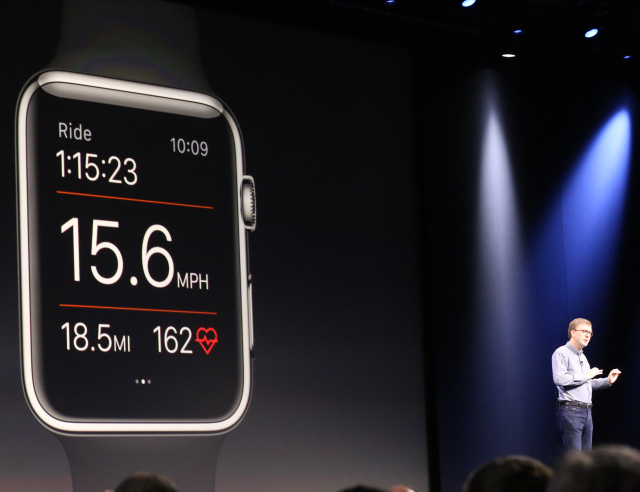
Sadly, management decided to narrow the focus to social networking features and shut down the Training team that I was on. On the bright side, I realized that the competitive landscape for data visualization had changed and I could resume working on my own startup.
But first, I had non-refundable triathlon entries to complete, Escape from Alcatraz and Ironman Coeur d'Alene, and I needed to move my stuff out of the expensive San Francisco apartment with the noisy neighbors. At the time, my sister was dating someone who had ordered a custom Sprinter 4x4 and was paying an outfitter to convert it into a camper as the outfitter's schedule allowed:
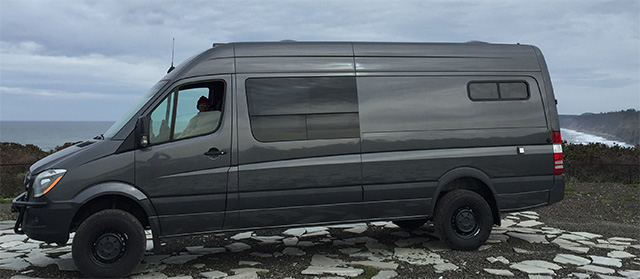
Curious, I watched some videos about Sprinter camper vans and read reviews of the new 4x4 option. Moving van rentals from SF to Seattle were more than double what it had cost me to move to SF in 2012, and I was going to need an AWD/4x4 vehicle for winter skiing trips. I had sold my AWD Subaru sedan in Seattle and didn't have a car for 4 years. Whenever I left the SF Bay Area I had to rent a car or 4x4 SUV, and that gave me a lot of opportunities to think about what kind of vehicle would enable the most outdoor opportunities. A 4x4/AWD vehicle was essential for winter skiing and made the per-day cost of skiing with a Mountain Collective pass more affordable and enjoyable than paying ticket window prices and driving 4+ hours each day of skiing. Subarus lacked sufficient clearance for Forest Service roads, and even station wagons or SUVs didn't have enough room to sleep two people in the back. I wanted to bring my bike on road trips without worrying about a thief seeing it in the rear window of a station wagon, hatchback or SUV and I needed a safe place to keep it at night.

I realized I could buy a 4x4 cargo van with my savings and a low-interest loan, use it for the move, and then covert it into a camper in Seattle with the skills I gained remodeling a condo and my mom's workshop, tools and help. A camper would allow me to train on the Ironman course and figure out pacing for the 90F heat on the hilly 112 mile bike segment.
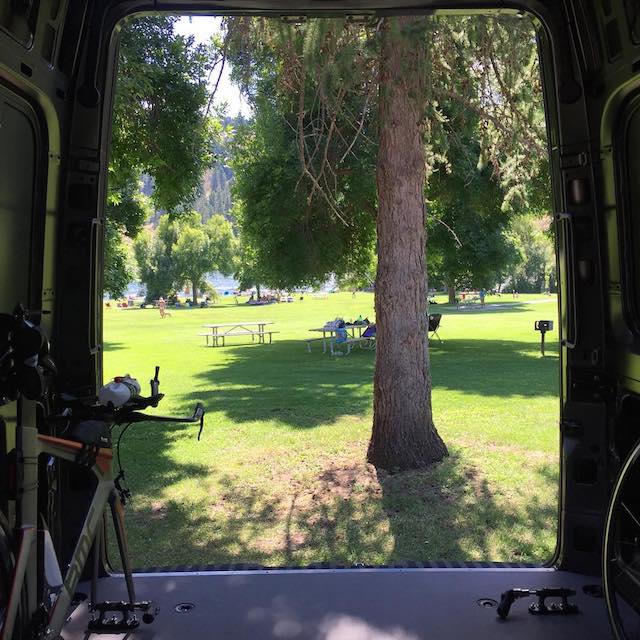
I searched across the West Coast for high roof Sprinters with both the short 144" wheelbase or the long 170" wheelbase. All 170" wheelbase Sprinters have the high roof, while only half of the short wheelbase Sprinters have the high roof. The 4x4 Sprinters were new and in high demand, plus features that should be standard (cruise control, rear view camera) were options that some dealers forgot to order. The only 4x4 high roof Sprinter available on a dealer's lot West of the Mississippi that had metallic paint (so it doesn't look like a white delivery van), cruise control, and a rear view camera was in Fargo, North Dakota. The van had just arrived at the dealer and in place of real photos was a rendering of the van.
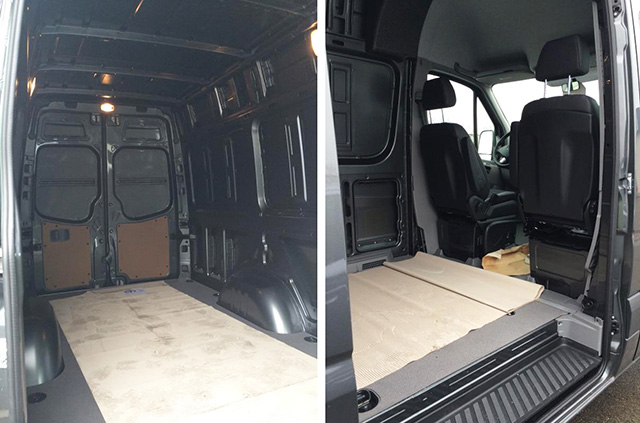
The dealer confirmed that the van still available for sale, and because it was a no-haggle dealership, the price was $3,300 under MSRP! I coordinated a loan through my bank and bought a one-way plane ticket from SF to Fargo. Then I drove the van to Mount Rushmore, Yellowstone, Coeur d'Alene, and Seattle for registration. Even in May, it got very cold at night in the uninsulated van so I knew that a good nighttime heater was going to be essential.
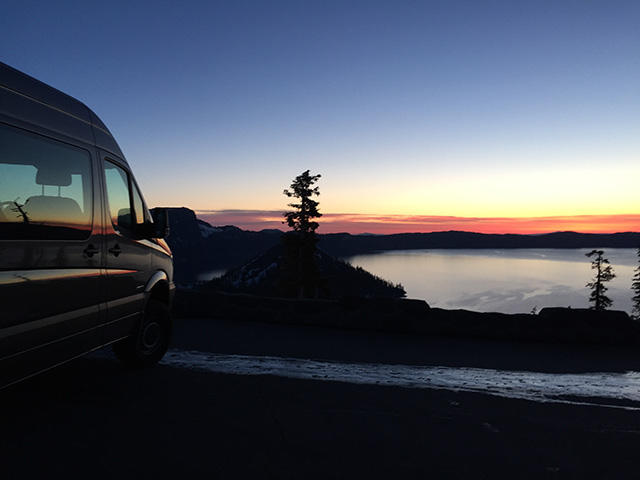
I spent a ton of time researching options for building out my Sprinter as a camper van and wanted to help simplify that process for others by outlining the key options and the choices I made all in one place.
Sprinter Van Configuration
4x4 with Low Mode
A rear-wheel drive van is fine for people who don't ski and plan on staying on dry paved roads. Besides the extra traction of 4x4, Mercedes also lifted the van 4" to allow greater clearance over uneven roads. The extra 4" of ground clearance is really helpful, especially for the longer 170" wheelbase in Utah:
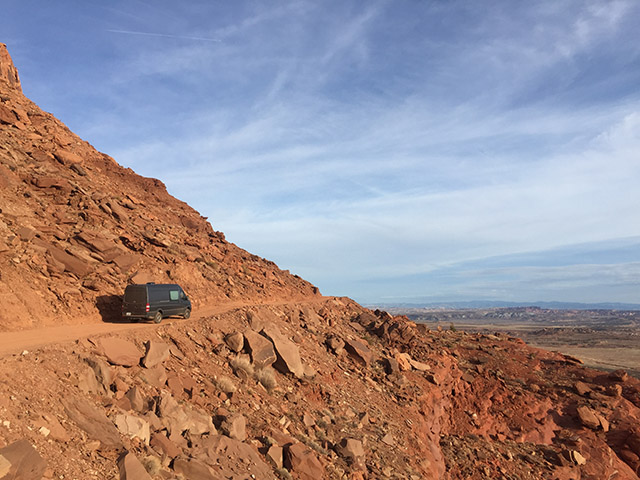
The Fargo dealer wisely ordered my Sprinter with the Low mode that allows the wheels to creep along with enough torque to move the vehicle but with lower wheel speeds to avoid spinning the tires. I've been on a mountain pass in regular 4x4 mode and felt the rear of the van slide toward a guard rail. I stopped and tried to move along slowly, but it was still sliding. Only switching into 4x4 Low gear allowed me to creep along slow enough to avoid sliding into the guardrail. Body work on the vans is expensive, so that feature definitely paid for itself!

170" Wheelbase
When I was searching for an available van, I wanted to buy a 144" high roof 4x4 van but couldn't find one available. Ultimately it was a good thing I got the 170" wheelbase because it has 40.8" more interior room, and I needed all of that room to move my stuff even after I gave away my mattress. (There is 14.8" more rear overhang on the 170" than 144")

While the 144" wheelbase Sprinters look better with the symmetry between the sliding door and the rear panel, most RV and camper van owners I've talked to start with a small camper or RV and trade up to a larger model. Building out a van takes so much time that you won't want to do it again, so it's better to get the longer size unless you routinely take ferries in Washington State or Alaska. Ferry car fares double at 22 feet, but it is still worth it for a trip to Alaska:

A 144" is fine for one person, but with two people the 40" of extra interior space is really helpful, especially if your campground is hit by a giant rainstorm and you're are stuck inside. For two days.
If you do get the 144" wheelbase, get a high roof with flares like on the Winnebago Revel so there is enough room to sleep across the width of the van.
Cargo instead of Crew or Passenger model
If you need to transport more than 2 people, a Crew van includes an extra row of seats and also includes welded nuts to move the seats farther back in the van. That way, the bench seats can be used as a step up onto a 36" or higher bed platform. Note that most people remove the ceiling of the crew van to add insulation and often replace it and the walls with their own material. So the only reason to buy the Crew is if you plan on driving more than one passenger on a regular basis. It is possible to retrofit seats into a Cargo van, but even if the seats do hold up in a crash they might not be covered by insurance since the vehicle is still rated for only 2 people. The Passenger model doesn't make sense for a campervan unless you regularly transport more than 5 people.
Layout with Queen Platform Bed over Bike Storage
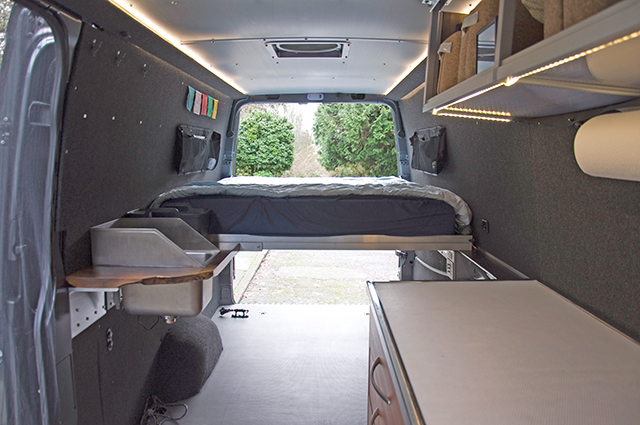
The 170" wheelbase van has plenty of room for a permanent queen bed in the back. It made sense to install a 5 foot long cabinet containing the fridge and drawers directly behind the driver's seat since the cabinet and the stainless-steel countertop could be wedged against the B pillar to prevent forward movement during breaking. (The dealer ordered the cargo van with provisions for a partition behind the driver's seat, so the B pillar steel was exposed without the normal vinyl covering.) It also made wiring to the 12 fuse DC block easy as it is on the face of the cabinet behind the driver's seat. Cables run from there under the driver's seat via a hidden conduit to the batteries under the passenger seat, and there is a shore power battery charger attached to the back of the driver's seat that connects to the DC fuse block. Since the seats are already very high off the ground, I didn't want to add to the height with a rotating seat base.
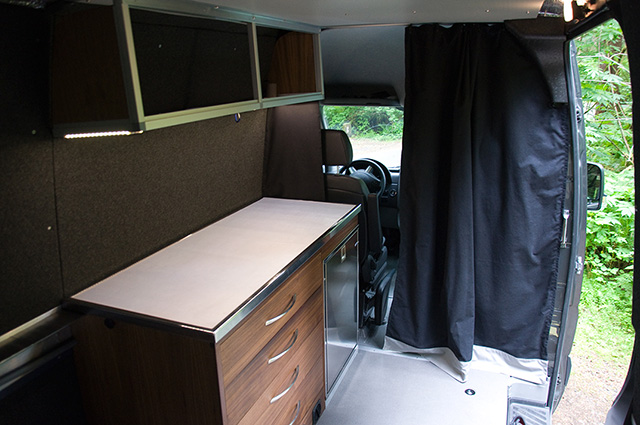
With my mom's help and tools, we built 4 drawer boxes out of 8" wide quartersawn walnut heartwood boards. This is a sliding dovetail joint:

A CompX Timberline gang locking system on each side prevents the drawer boxes from launching when the van turns hard left. It should also deter theft:
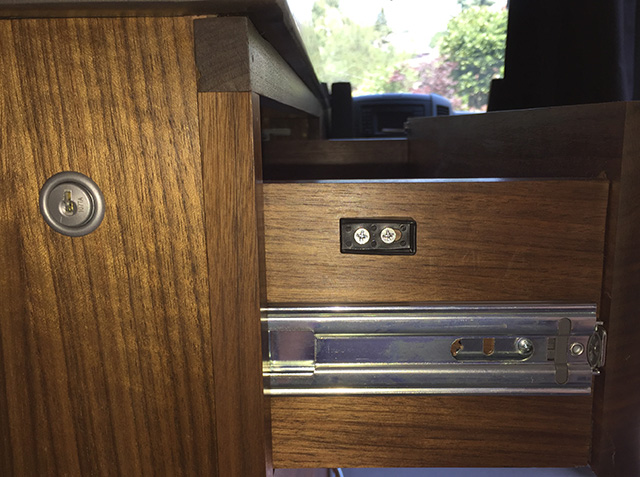
It is space efficient since there are no horizontal supports between drawers (which is why simple push-locks wouldn't have worked). But it was complicated to design and very time consuming to implement:
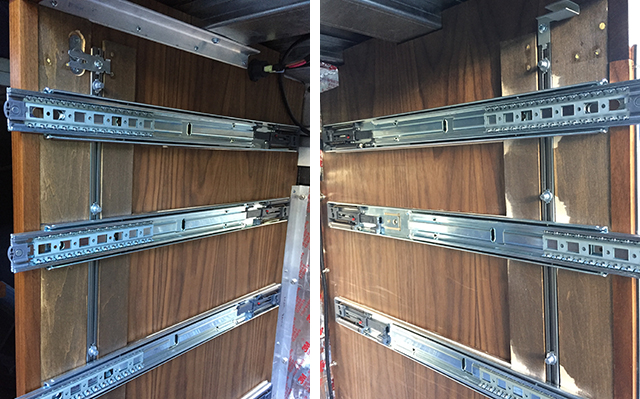
The soft-close drawer slides required the drawer boxes be accurate to within a millimeter of the 838mm wide space (0.1%). A CNC-cut cabinet could achieve such precise measurements but since we used a table saw it ended up requiring a lot of additional filing and sanding for smooth drawer operation:

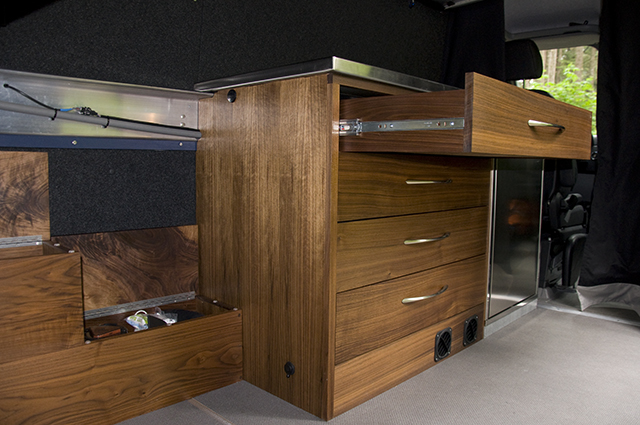
Bolting to the van interior
Everything added to the van interior needs to be securely attached to the van's sheet metal, and that requires either using bolts with a nylon locking nut where it is possible to access the back of the sheet metal, or using either rivnuts or plusnuts. Plusnuts are stronger than rivnuts when installed with the right tool because they form a plus sign as the flanges of the nut are compressed against the sheet metal, while the rivnut forms only a thin ridge and can be pulled out of the pilot hole with sufficient force. For strength, it made sense to use plusnuts, and for rust resistance I wanted to use stainless steel. I found a company with an online catalog that included stainless steel plusnuts but it required calling to order. I asked for the pre-bulbed version but there was some confusion and they ended up sending me regular plusnuts (not the pre-bulbed version I intended.) I should have returned them immediately but they charged for shipping & handling and I thought the tool I bought from McMaster-Carr could install all plusnuts. Ultimately the tool wasn't strong enough to compact the high-strength stainless steel plusnuts into the intended plus sign, and instead twisted them into a swirl that probably wasn't more resistant to pull-out than a rivnut:

After I used up all of the plusnuts to attach the aluminum angles for the bed platform rails and cabinet with stainless steel top, I got 100+ stainless steel rivnuts to attach the lightweight wall and ceiling panels.

Stainless steel plusnuts are more expensive and hard to find so I recommend using stainless steel rivnuts with the Astro Pneumatic Hand Rivet Nut Setter for the wall and ceiling panels and only using pre-bulbed plusnuts for attaching heavy items like cabinets that could pull a rivnut out of the van sheet metal.
Espar Diesel-Powered Air Heater
I got the Espar D4 because a thorough comparison of the Espar D4 and D2 noted that the Espar D4 uses less electricity than the D2 at the low speed while moving far more air. I assumed I could set the Espar to run at the low speed, but the DigiMatic thermostat is set using temperature, and the D4 is so powerful that it will reach the set point and shut off unless the thermostat is set for 67F or higher. Because both heaters go through the loud boost mode each time they turn on, it is better to have a smaller D2 stay on than get the bigger D4 and have it cycle on and off. Also the D2 kit costs half as much as the D4 kit. Note that I did get the high altitude pump (instead of the more complicated adjuster) since Taos Ski Valley is over 9,000 feet and they allow camping in the parking lot for 7 days. The primary noise for either Espar is the ticking of the fuel pump and even though it's under the driver's door near the fuel tank inlet, the ticking sounds loud inside the van on the bed 8 feet away.
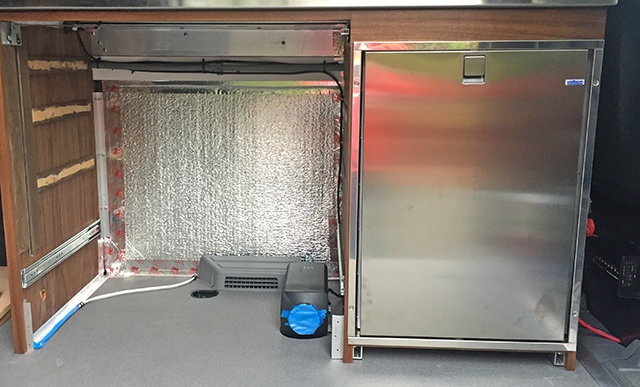

Espar also makes a D5 Hydronic glycol heater that can be used to heat air with a radiator and water using a heat exchanger, yet the plumbing is much more complicated than for the D2 or D4 air heaters. Initially I wanted to install a glycol heater since the van came with a version of the D4 modified as an engine block heater. When I realized it required complicated plumbing with a glycol expansion tank, I decided to go with the simpler D4. Now I recommend most people go for the less expensive Espar D2 since the D4 is overkill.
Webasto makes a heater than can heat air in winter and air and water when nighttime temperatures stay above freezing. Freetired installed a Webasto Dual Top Evo in his van and he's happy with it, though it sounds like the warranty is only valid if it is installed by a dealer and troubleshooting it is complicated. Since it heats water instead of glycol, the plumbing is less complicated than the Espar D5 hydronic heater.
With all of these Diesel heaters, yearly maintenance is required to clean off any soot. Also, the kits don't come with air intake filters, though Hein on the Sprinter Forum has recommended using this lawnmower intake filter.
Thinsulate Insulation with Trunkliner-covered Plastic Interior Panels
I'm very allergic to mold and wanted to avoid insulation and wall coverings that could support mold. That lead me to Thinsulate for the insulation in the wall cavities of the van (over butyl sound dampeners) followed by Polycarbonate greenhouse panels from TAP Plastics covered with Trunkliner.
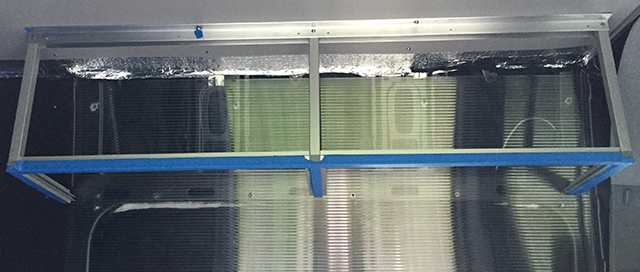
Both the Thinsulate and the Trunkliner are attached with 3M 90 spray adhesive:

AGM Batteries
The market for durable and rugged 12V lithium batteries over 100 amp hours is still in it's infancy, and I've personally encountered enough issues with lithium computer batteries expanding (over 2 years!) that I'm skeptical of any claims for battery life over 10 years in an environment with both high heat and freezing cold. (Lithium batteries start to degrade over 77F and cannot be charged below 32F.) Lithium batteries need more complicated monitoring and charging equipment to ensure the cells are evenly depleted and charged, while AGMs can just be chained together and will equalize automatically.
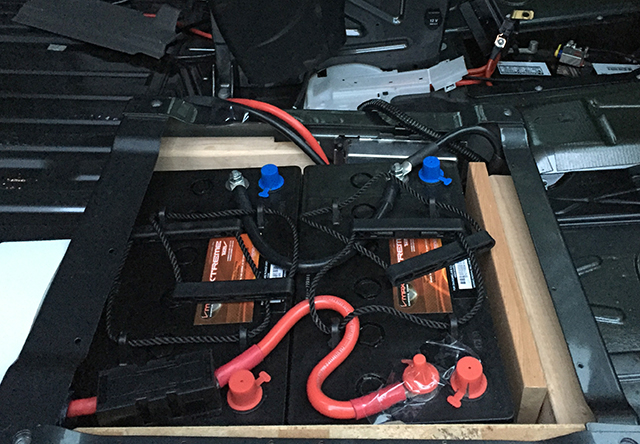
I got two group 31 extended (taller) VMAX XTR155 AGM batteries (most reviews are for the less-rugged VMAX SLR155) and installed the combined 182 lb weight under the passenger seat to improve left-to-right weight distribution. The driver's side has the Mercedes 100 amp AGM battery, 170lb Diesel tank (when full), 170 lb driver, 77 lb fridge surrounded by a 5 foot long cabinet full of stuff and topped with a 58 lb stainless steel countertop, with wall-mounted shelving above. The sliding door limits the weight on the passenger side.
Those batteries fit perfectly under the seat, though I spent a lot of time carving wood 2x6s to ensure the batteries can't move around. I searched for Lithium batteries in that size (or the combined 12.9"w x 14"d x 10.8" dimension) but the only group 31 LiFePo batteries were 150 AH or lower. While lithium batteries can be discharged more heavily than even a deep-cycle AGM, it made sense to start with affordable AGMs and wait until they won't hold a charge before reevaluating. Lithium batteries can't be charged up below 32F and I typically use the van for ski camping, so a common scenario involves driving the Sprinter down a mountain after skiing and using the alternator (and the battery-to-battery charger connected to the alternator) to recharge the house batteries below 32F.
Alternator Battery Charging
Charging using the 220 amp alternator seemed like a no-brainer, though I did make sure to get the Sterling 30 AMP Battery-to-Battery charger to support 3 stage charging (bulk, absorb, float). The charger can draw up to 30 amps from the alternator (and 100 AH starter battery) which is basically the most load Mercedes recommends putting on the vehicle electrical system. My van didn't come with the factory auxiliary battery, which is just as well since it's not useful as a campervan battery. There is an electrical conduit under the floor between the driver and passenger seats where I ran 2 AWG factory-terminated cables to connect the vehicle battery to a red disconnect switch and then a 6 AWG cable connects the Sterling charger to the house batteries. (6 AWG is the thickest cable that will fit in the Sterling screw terminals.) 4 AWG cables run from the house batteries back through the underseat conduit to the fuse box mounted to the cabinet behind the driver's seat. There are 100 amp mega fuses on the batteries and large red switches to fully disconnect the house batteries from the vehicle battery and from the fuse box for the house electrical system.
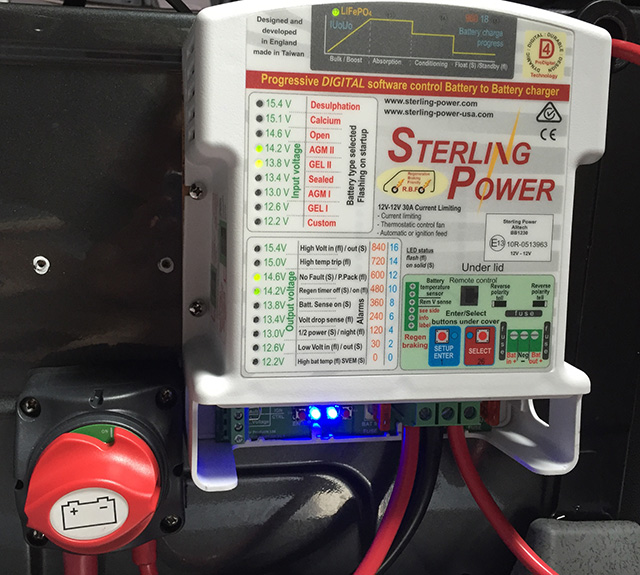
I also got a VMAX multi-stage battery charger so I can plug the shore power connection into the grid to recharge or maintain the batteries.
DC Transformers instead of an AC Inverter
I was going to buy the Magnum 1000 watt Inverter/Charger for AC power and shore power charging when I read reviews that said it failed due to power surges from the shore power charger and the manufacturer wouldn't replace it under warranty without also purchasing an expensive remote display. If you do need a DC-to-AC inverter, it is better to get an inverter-only model and buy a separate AC-to-DC battery charger or use solar to charge the batteries.
Most electronic devices use DC power and it is more efficient to transform the DC voltage than to convert it to AC and back. To charge phones and other USB devices, I got a Blue Sea USB fast charger. To charge my Macbook Air, I bought a DC transformer that fits into a car/cigarette outlet. DC car vacuums work well.
Portable solar panels
Because my initial use for the Sprinter was primarily winter ski trips in the Pacific Northwest where snow and ice on the roof were a concern, I've held off on drilling into the roof to install fixed solar panels. The Isotherm 130L drawer fridge is the biggest power draw using 430 watts in 24 hours (34 amp-hours at 12.6+ v), and I usually only use it to keep fruits and vegetables cold:
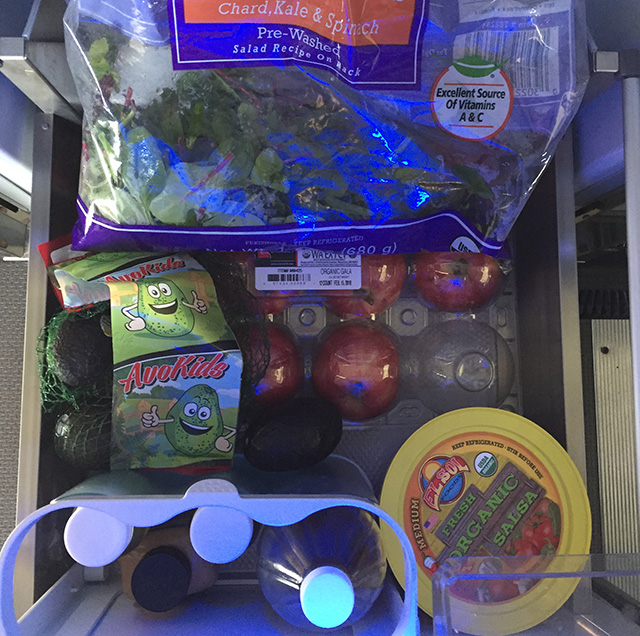
I can stay parked for 3 nights without draining the 310 amp-hour AGM batteries below 50%. I verified this at Denali where the van sat for 96 hours before briefly recharging it on a 15 mile drive to the Savage River campground, and then again in Key West. (The fridge is on a separate switch so I can turn it off when I'm more worried about power usage than cold food storage, or during the ski season when I don't want the heat from the Diesel heater to cause the fridge to cycle incessantly at night.) My trips to Alaska and then to Florida have involved a lot of driving so recharging the batteries by driving to a new campsite hasn't been a problem. I've been surprised how many campsites have electrical hookups at low or no additional cost, and the great thing about being in a campground with hookups is that your neighbors won't be running their generators. However now that I'm more comfortable finding free Forest Service and BLM campsites, I'm going to add a solar charging system so I can stay in Sedona for more than 3 nights:

Besides snow loads and the inefficient angle of fixed flat roof solar panels during the winter, spring, and fall, I'm worried that roof-mounted solar panels would cause wind noise and reduced MPG at freeway speeds. So I'm going to get a portable 200 watt panel and a Morningstar MPPT solar charge controller. Both Zamp Solar and GoalZero make 200watt portable panels, although the Zamp kit includes a PWM solar charge controller on the back of the panels while GoalZero requires an external solar charge controller. Because there will be voltage drop from the batteries in the van to the solar panels, it makes sense to install the solar charge controller in the van near the batteries with a Anderson Power Port that can be used to connect solar panels outside. Installing the solar charge controller in the van reduces the fear of having the panels stolen since replacement panels aren't as expensive as an all-in-one kit with an outside solar charge controller. In the future, I could also build a carport with solar panels on some off-the-grid land and use the carport for cooking and showering while keeping all of the valuable electronics in the van.
No built-in shower or toilet
I'm very allergic to mold, and even though the wall materials are all synthetic, dust can accumulate on them and combine with condensation to create mold. In areas with high humidity, water condenses on the ceiling with two people in the van, and that would get far worse with an indoor shower. Almost every RV park has showers and will allow visitors to pay $3-6 to shower, and truck stops like Love's have very clean $12 showers that come with fresh towels.
When I'm staying somewhere without shower facilities, I set up an exterior shower using a pop-up shower tent, a cement mixing tray, a 12V shower pump and a gallon Yeti rambler. The cement tray is great for storage while driving and can catch overflow from the sink's graywater container, and the shower tent is a good way to mark that a campsite is taken if you take the van for a day trip.
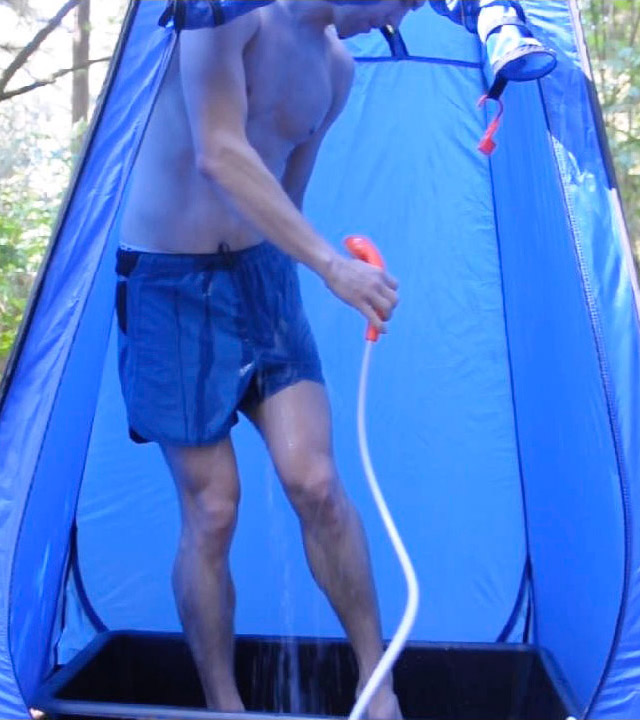
Fixed Sink with Hand Pump
Before I bought a stainless steel sink, I got a portable wash basin that I now use as a drying rack. Since the 36" tall space below the bed is tall enough for me to crawl-walk through, I wanted to keep it unobstructed by cantilevering the sink counter using a massive 8"x8"x0.5" aluminum angle and the aluminum box tube of the bed platform. That keeps the floor area free so 4'x8' panels can be transported in the van for future remodeling and construction projects.
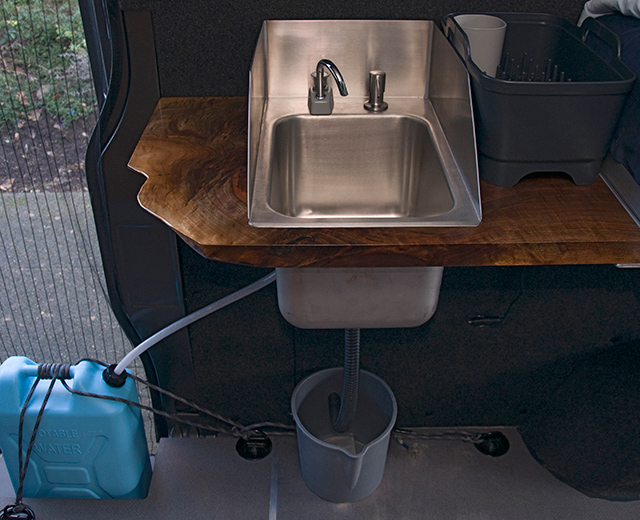
The sink is deep enough that I can use it to wash sunscreen off my face and shampoo my hair. I use a hand pump to draw water from a 5 gallon HDPE jerry can. The hand pump conserves water and avoids creating excess graywater. A large clear water bottle (not shown) collects the gray water so it's easy to see the water level and it can be carried into a bathroom and poured down a toilet.
In the winter, I don't want to worry about cold damaging the plumbing or keeping the van warm while I'm skiing. Freezing isn't a problem for HDPE jerry cans and it's the same plastic used for frozen soups and ice cream. The best place to store jerry cans is at the rear side of the sliding door interior step, as it won't fall over and can be roped to the D rings around the step. Additional jerry cans are carried at the rear of the van.
JetBoil for Cooking
I'm cooking with gas because my JetBoil heats water fast while 12V DC takes forever to heat water. The JetBoil makes enough hot water for coffee and oatmeal and helps heat up the van in the mornings. (In the summer I make cold brew coffee.) I use a lot of spices in my cooking and don't want the van to smell like cumin, so I cook meals outside or just eat at restaurants.
The Sprinter van is a perfect portable cabin. It allows me to escape cloudy Seattle during the winter while enjoying the Pacific Northwest and Alaska during the spring, summer and fall. While the cost of hotel rooms and AirBnBs has increased dramatically, most public campsites have reasonable prices and a lot of public land allows free dispersed camping. Even after converting the van to a camper the cargo space under the bed will accommodate 4'x8' sheets of plywood, insulation, drywall, etc. for remodeling projects.
Hopefully this post has helped clarify how and why I converted a van into a camper. It was a ton of research and construction work so most people should hire an outfitter or buy a converted van like the Winnebago Revel. Even in that case, it is still important to know which features to choose.
Update: 2019 Van Video Interview
Buying products I link to on Amazon gives me credits at no cost to you. As an Amazon Associate I earn from qualifying purchases.
